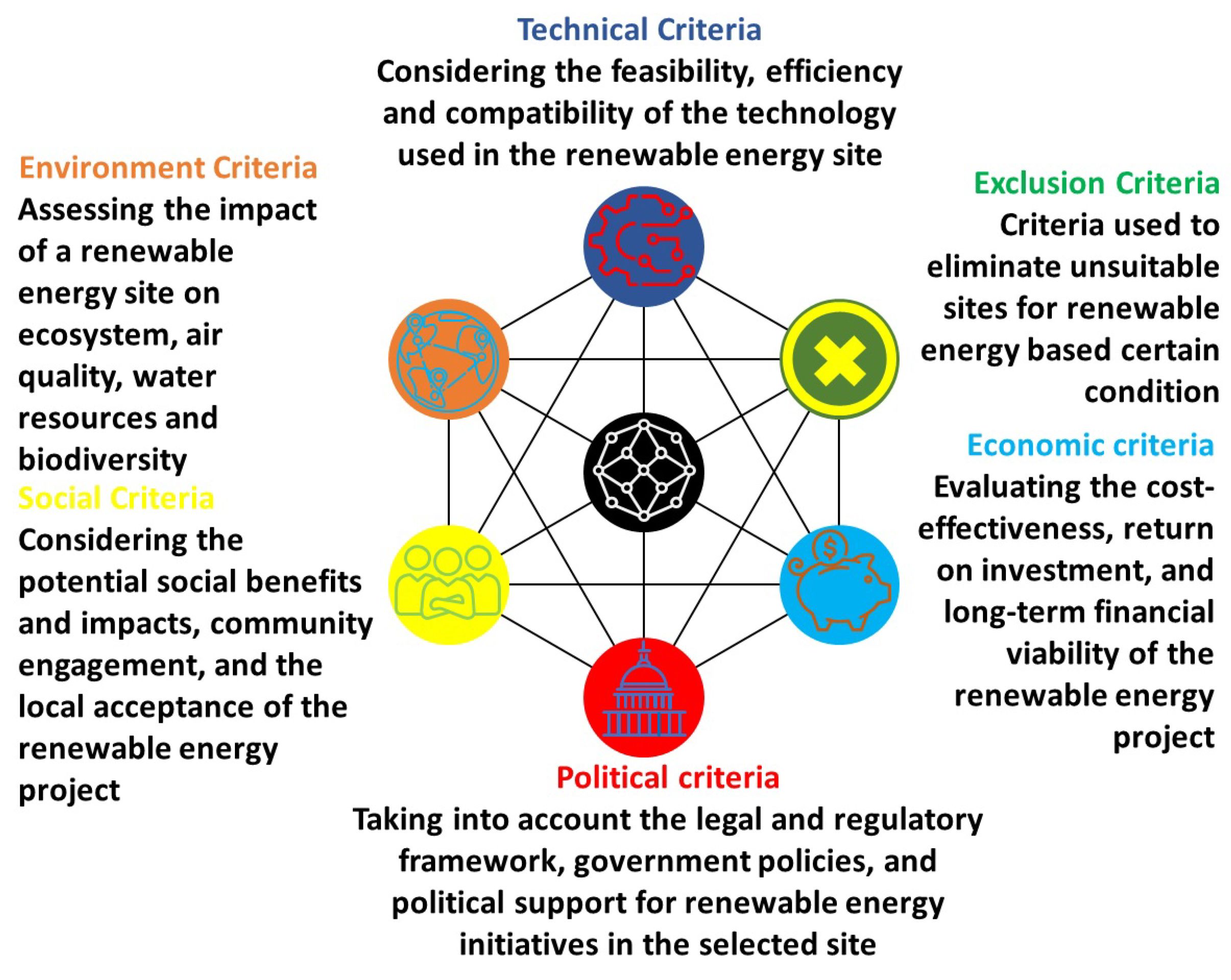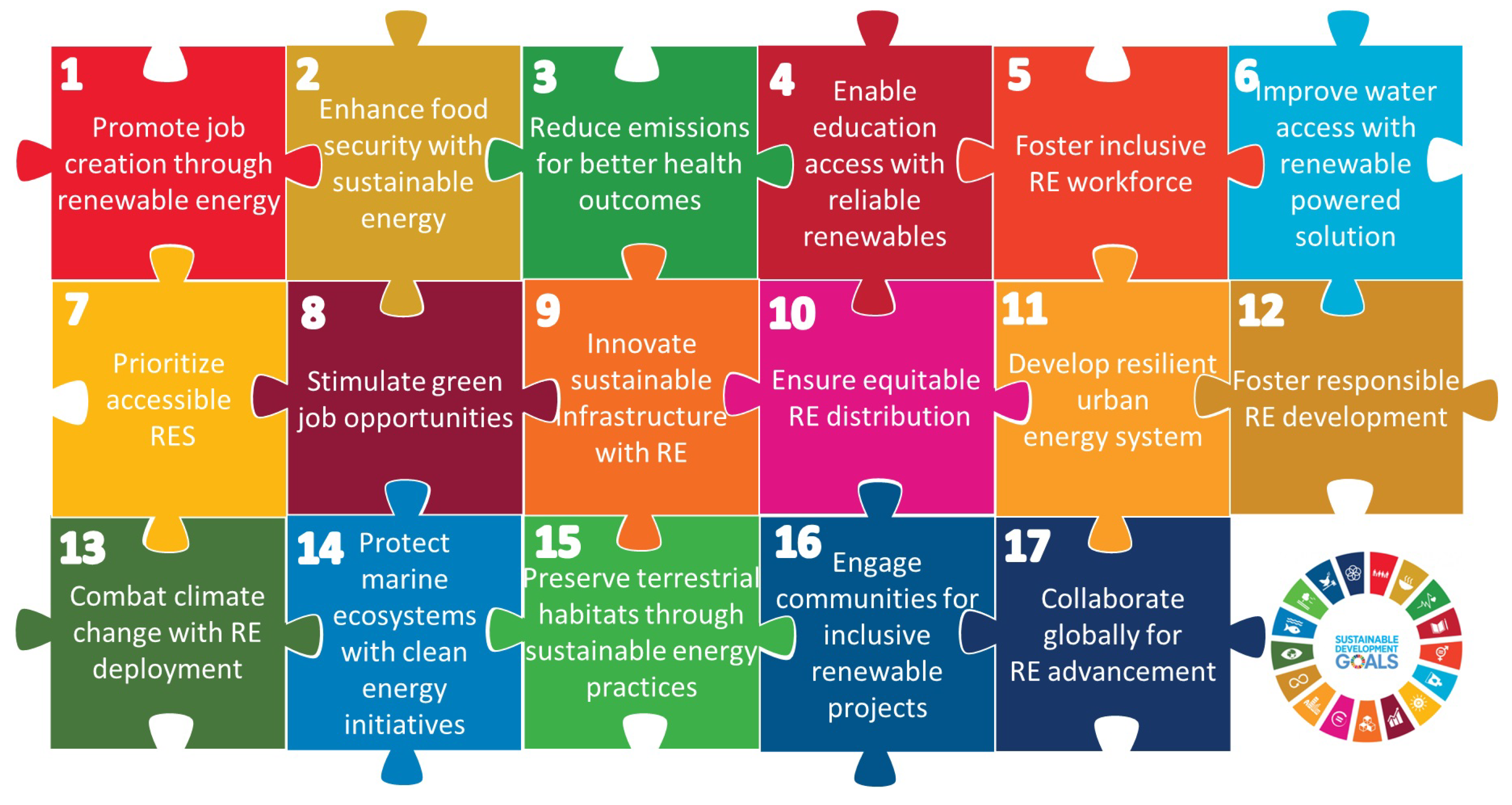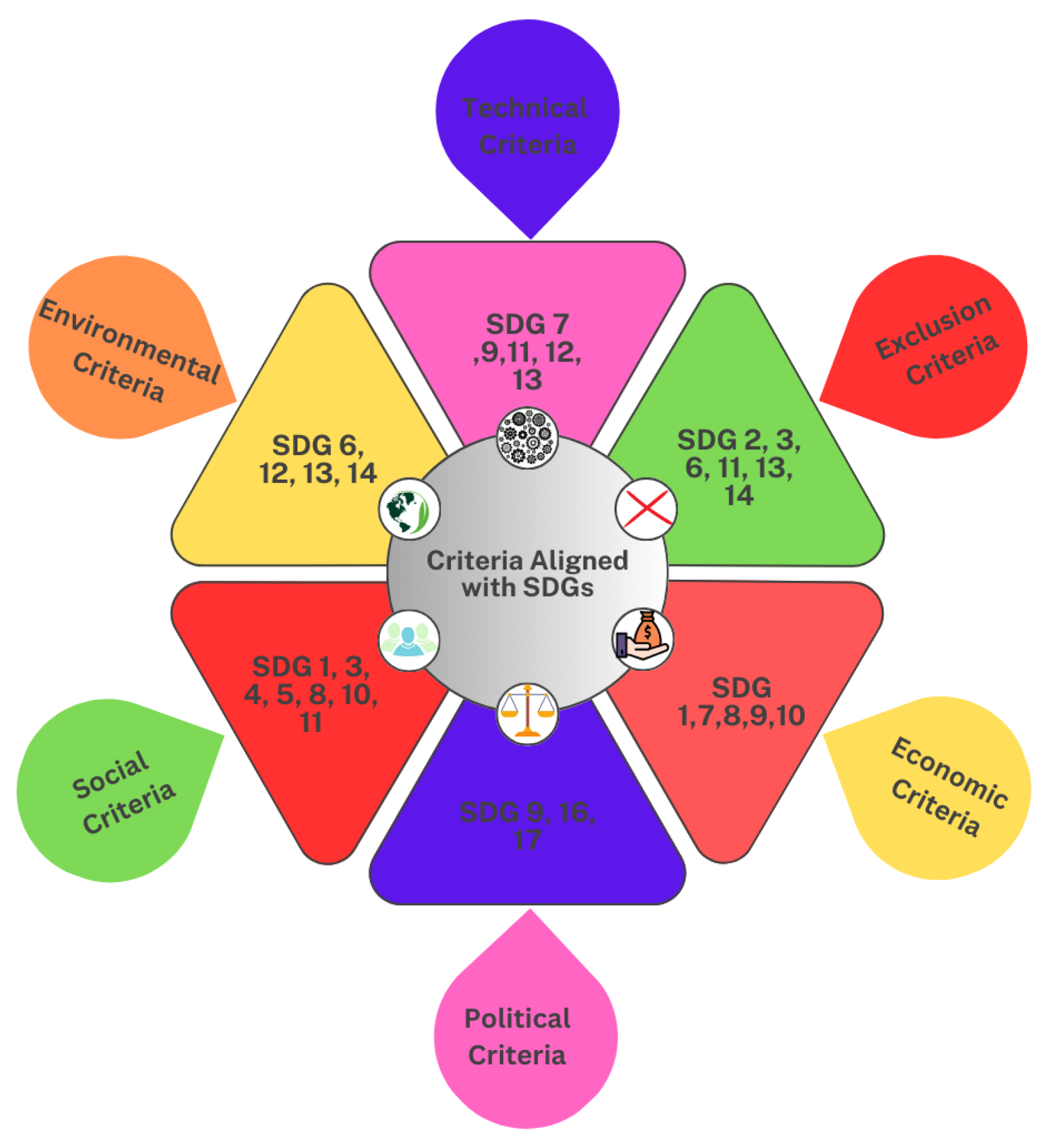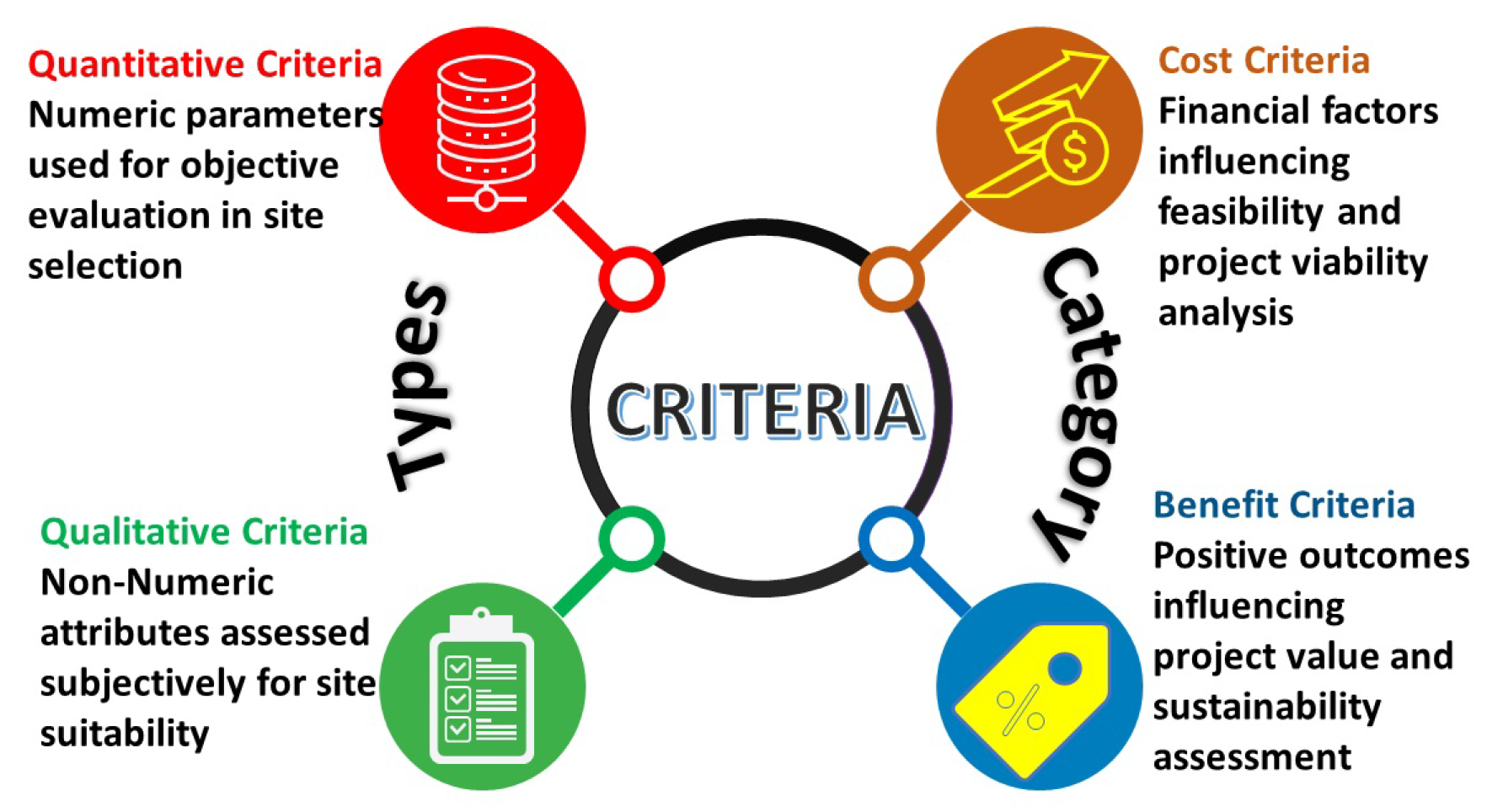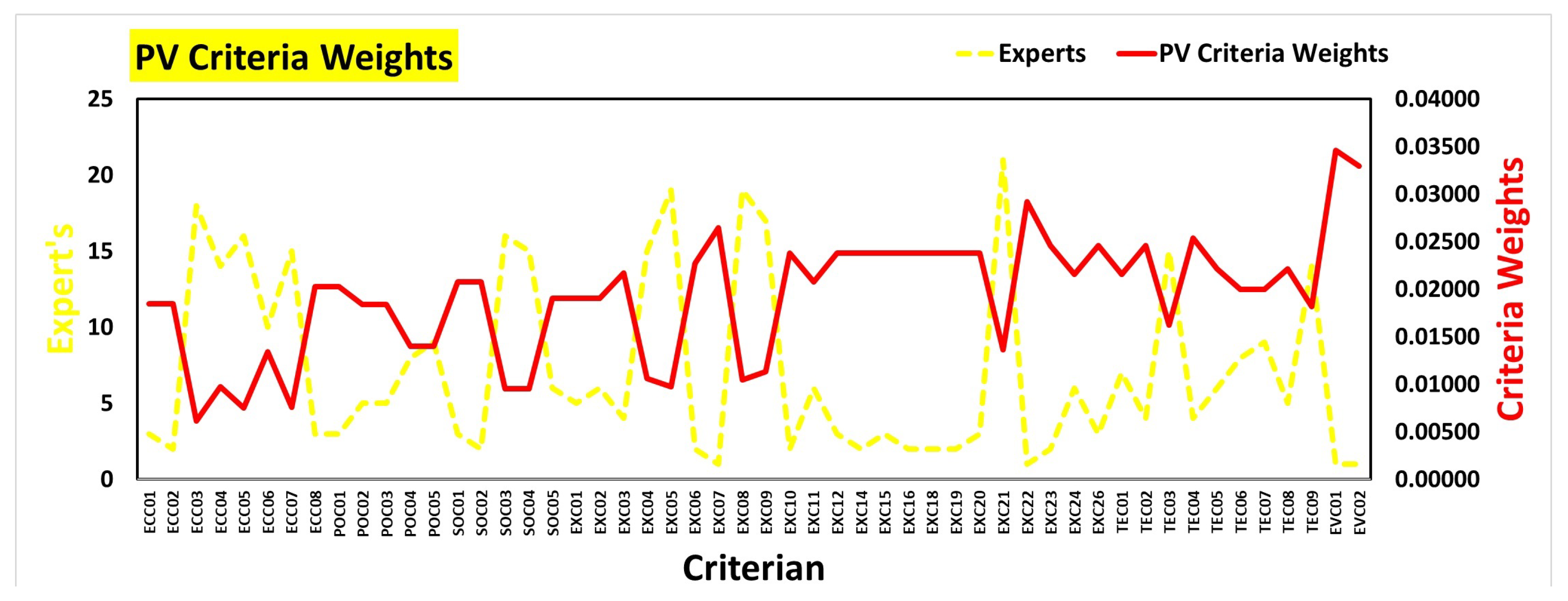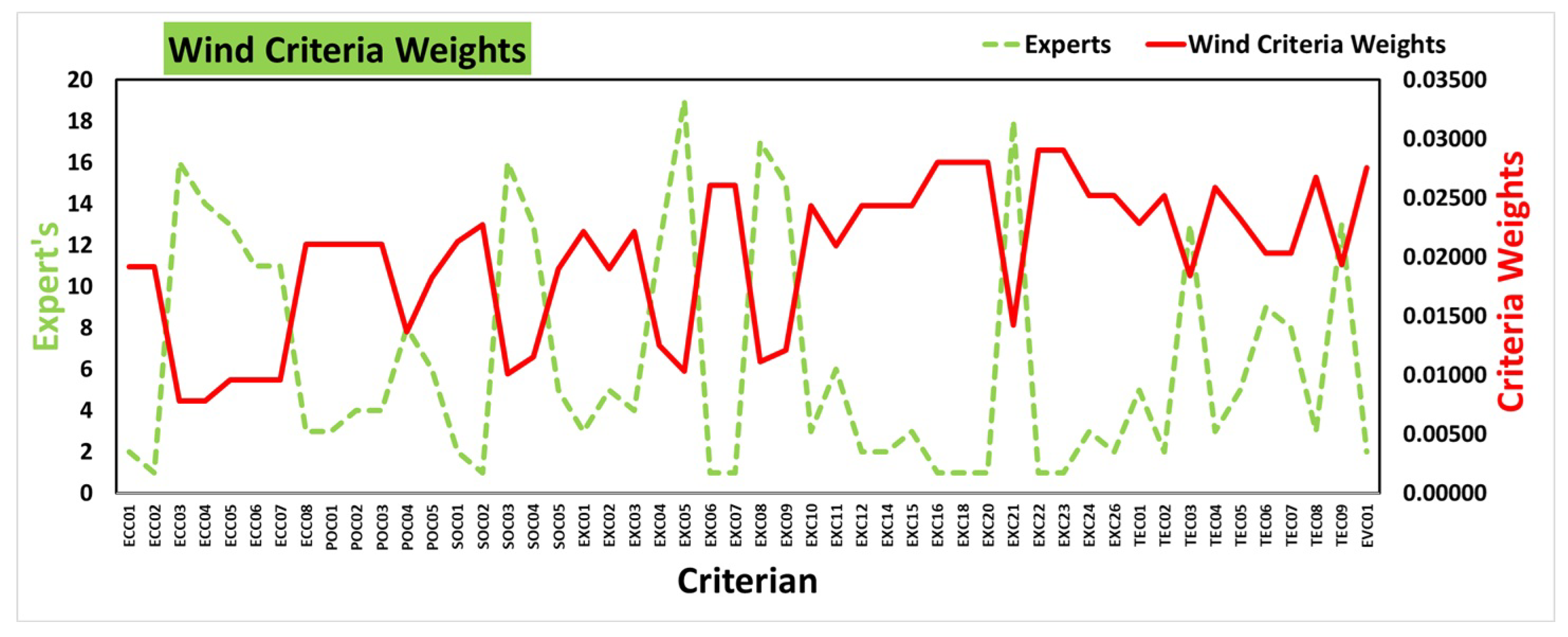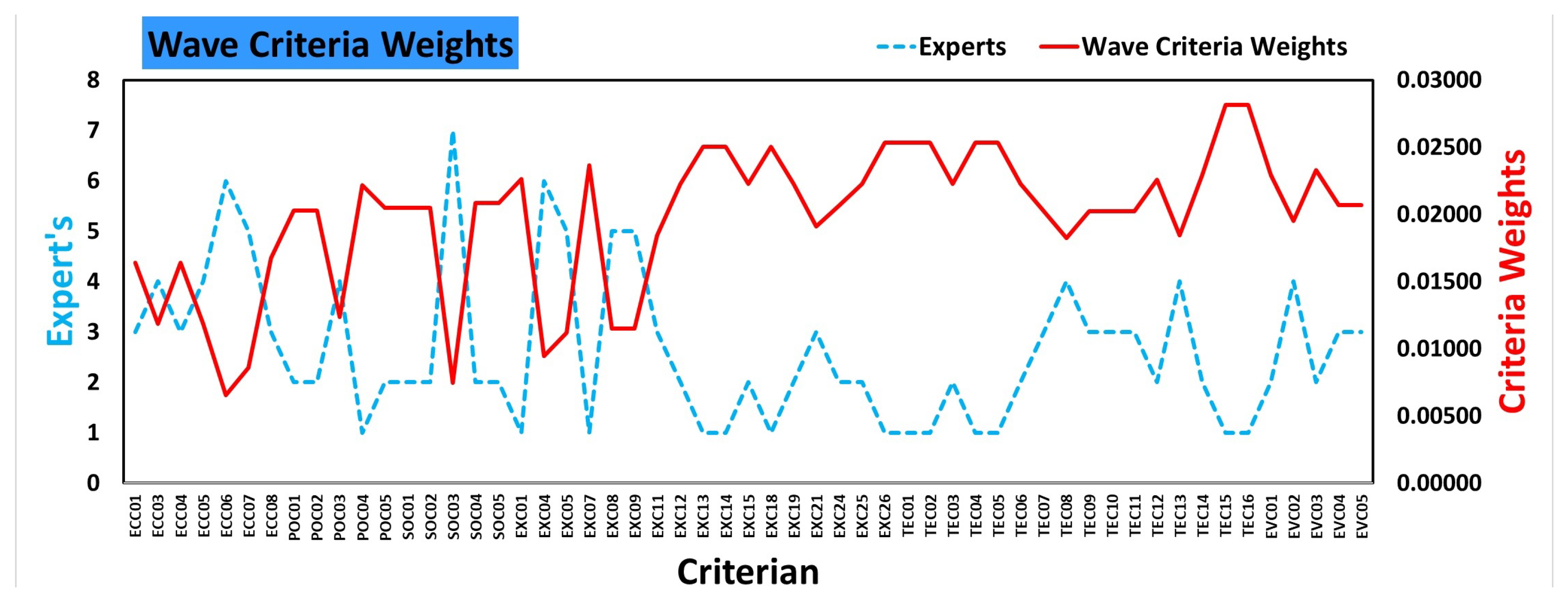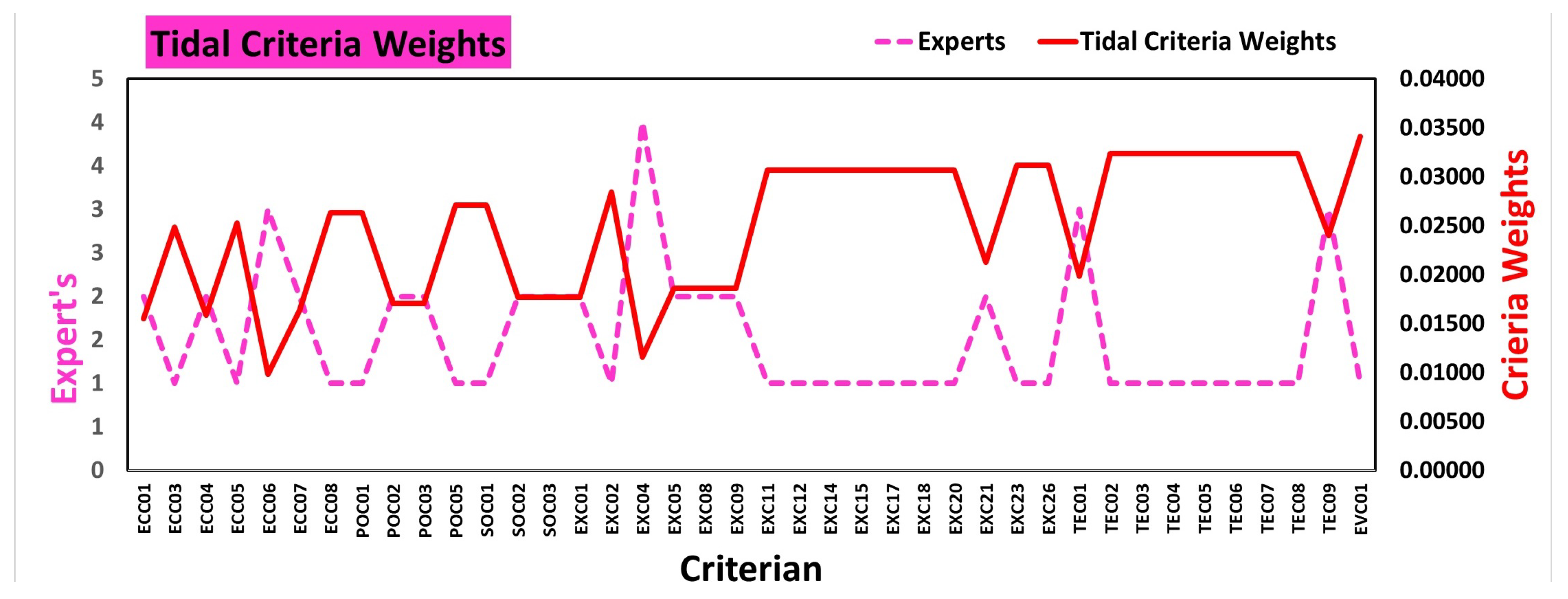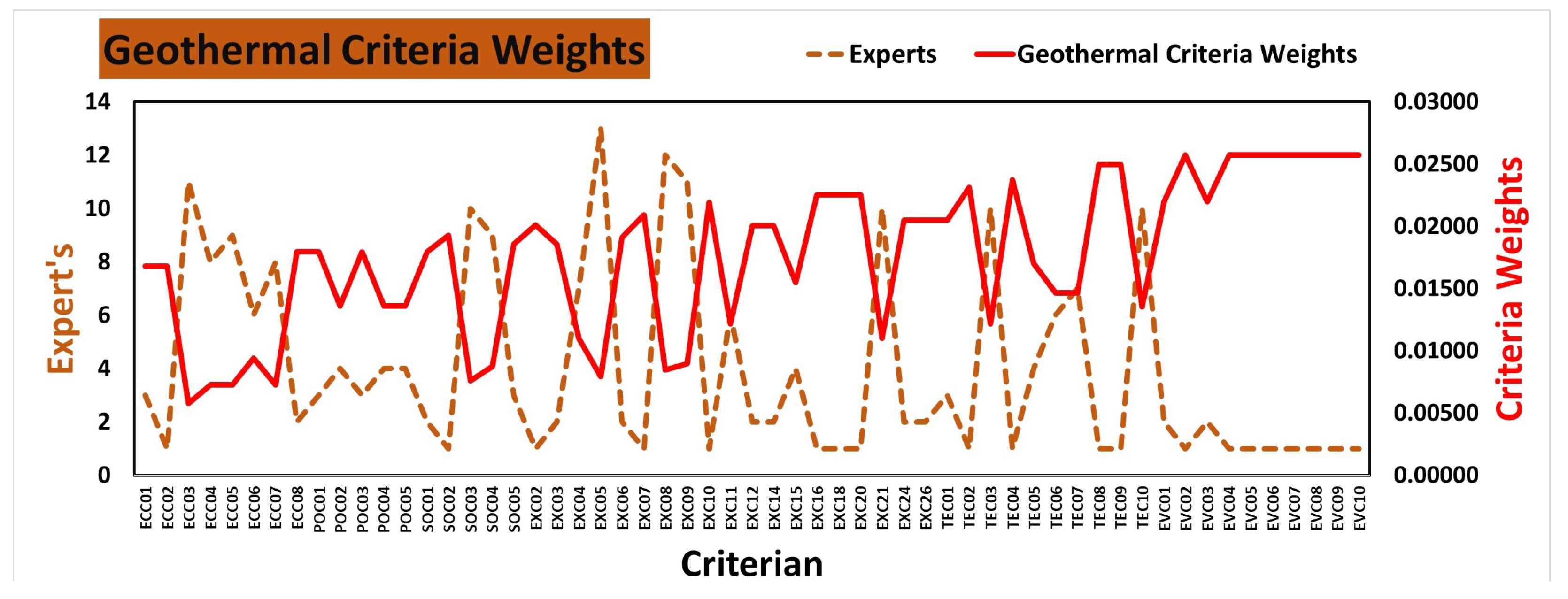Appendix A
Appendix A.1. PV Technical Criteria
(i) Annual solar irradiance: Annual solar irradiance is the solar energy received by a site within a year. This would then be the most important design parameter in identifying the viability and development potential of a solar farm, especially for the generation of solar photovoltaic energy conversion at maximum efficiency to optimize production and project efficiency.
(ii) Aspect: Aspect can be referred to as the directional orientation of a slope or landscape, and site selection for solar farms depends on it. Aspect will help in the identification of the best terrain that faces south—which will guarantee maximum sunlight exposure in the Northern Hemisphere—to enhance the efficiency in the placement of solar panels.
(iii) Efficiency: The efficiency of a system refers to the energetic efficiency, which represents the output/input energy ratio. This is one of the important parameters showing how well the power plant can convert input resources into useful energy output and highlighting system performance in terms of optimization.
(iv) Flexibility: The flexibility of site selection means the ability of a renewable energy system—solar farms—to integrate various sources of energy. Through this capability, the network is able to have increased efficiency in peak load demand management, making the energy system more flexible and resilient.
(v) Lifetime: Lifetime refers to the operational period of a solar power plant, typically measured in years, during which it effectively generates energy before requiring decommissioning or significant refurbishment.
(vi) Plant capacity: It is defined as the amount of electricity a power plant is capable of generating under ideal conditions. Considering the appropriate unit measures of either megawatts or kilowatts, this forms the most important basis on which the efficiency of a plant in meeting demand should be based. This ensures that the plant works within peak loads and hence the assurance of reliability on the grid.
(vii) Reliability: Reliability can be understood as the capability of an energy system to continuously perform its intended functions under predefined conditions over a predefined time period. This criterion is of basic importance in the context of providing uninterruptible power supply, minimization of downtime, and stability of the concerned systems; hence, this aspect needs to be seriously considered from both planning and operational viewpoints for energy systems.
(viii) Slope: Slope can refer to the tilt or gradient of a site, which could influence the construction or efficiency of an energy project. In the case of a PV system, slopes may be limited to 5 degrees maximum in order to guarantee structural stability, ease of installation, and to optimize energy generation by minimizing shading and maximizing exposure to sunlight.
(ix) Technical maturity: Technical maturity designates the degree of development, reliability, and readiness of a particular technology. It reflects dependability proven in practice and the suitability of the technology for practical implementation. This criterion is important to determine the level at which a given technology can provide satisfactory performance and be fully integrated into the intended energy system or project.
Appendix A.2. Wind Technical Criteria
(i) Wind speed: Technical maturity denotes the level of advancement, reliability, and readiness of a specific technology, reflecting its proven dependability and suitability for practical implementation. This criterion plays a pivotal role in assessing the technical and financial stability of a site, ensuring that the chosen location aligns with the operational and economic goals of the project.
Appendix A.3. Wave Technical Criteria
(i) Mooring system: The mooring system is the anchoring and positioning mechanism that holds a device in place. This category evaluates the actual device operational requirements against the design of the mooring system, taking into account considerations for stability, durability, and site conditions. It is critical to ensuring system performance when exposed to a range of environmental and operational stresses.
(ii) Inverter installation capacity: This criterion evaluates the presence or potential to integrate an inverter within the energy system to facilitate the conversion of DC (direct current) to AC (alternating current) for grid compatibility. It ensures efficient energy utilization and seamless grid connection, making it a crucial factor in the overall system design and performance.
(iii) Wave height: Wave height, which is the vertical distance between the crest and trough of a wave, remains the most critical parameter to assess energy potential in various wave energy projects. The wave height would be higher for the higher energy generation capacities. Hence, this acts as a major factor in site evaluation.
(iv) Mean wave energy flex: Mean wave energy flux is the quantification of the average rate of energy transfer through waves, which plays an important role in assessing the potential at a site regarding power generation. Hence, it fulfills the criteria of the feasibility of wave energy projects based on efficiency.
(v) Distance between two waves: Normally, it refers to the wavelength, which denotes the distance between two consecutive wave crests or troughs and forms a critical parameter in wave energy systems. The spacing and timing of consecutive waves arising from this parameter affect power generation efficiency through the potential energy transfer rate. This measurement becomes of utmost importance in the design and positioning of the wave energy devices.
(vi) Number of waves: The number of waves is one of the important parameters considered in wave energy analysis, and it can be defined as the number of waves within a specified time or distance. This characteristic is reflected in energy density and hence power generation potential, thus enabling optimization in design and positioning for efficient energy capture.
(vii) Wind speed: Wind speed is a significant factor influencing wave formation and energy transfer, indirectly impacting the performance and viability of wave energy converters. It helps determine the energy potential of waves, making it a critical parameter in assessing the feasibility and design of wave energy systems.
(viii) Wave duration: Wave duration refers to the time interval for a wave to traverse a specific point within the energy system. This criterion is essential in evaluating the performance and efficiency of wave energy converters, as it impacts the energy capture and operational stability of the power plant.
(ix) Ocean salinity levels: Salinity of the ocean is a measure of the concentration of salt in seawater. Though it does not directly affect the wave energy conversion process, it might have an indirect influence by varying the rate of equipment corrosion and efficiency of energy systems. Therefore, salinity levels are important from the point of view of estimating the durability and maintenance needs of a marine-based power plant.
(x) Anchorage facilities: The anchorage facilities are defined as those installations and systems developed for the safe mooring of wave energy devices. They involve ensuring stability and functionality for converters of energy in changing conditions at sea and, therefore, they are an integral component in operational efficiency, reducing risks related to displacement or structural damage.
Appendix A.4. Tidal Technical Criteria
(i) Tidal current velocity: The tidal current velocity becomes very important in designing and operating tidal current power plants. It directly influences the efficiency and operational state of tidal current power production devices, which determines the energy generation potential and ensures that the systems operate optimally.
(ii) Water depth: Water depth is a critical criterion that significantly influences the technological feasibility of tidal current power plants. The anchoring mechanisms of tidal current power-generating devices vary, which imposes restrictions on their installation depth, thereby affecting site selection and overall system deployment mechanisms, limiting their installation depth.
(iii) Tidal current power density: Tidal current power density is a key criterion that quantifies the energy available in tidal currents for power generation. It serves as an indicator of the resource potential, reflecting the amount of tidal energy accessible for effective utilization by tidal current power-producing equipment.
Appendix A.5. Geothermal Technical Criteria
(i) Thermal flux: Thermal flux represents the rate at which heat is transferred through a geothermal resource. This criterion is essential in determining the capacity and efficiency of geothermal power generation systems, as it directly influences the potential energy output of the resource.
(ii) Intrusive rock: Intrusive rock refers to the existence and density of igneous rocks formed from magma that then solidify beneath the Earth’s surface. This criterion is important because in most instances, areas with intrusive rocks are sufficient to illustrate their capability for heat retention and power production during an extended period.
(iii) Drainage density: Drainage density is the closeness of drainage routes like rivers and streams in a particular area. This criterion can prove quite important when an assessment for geothermal potential is performed, since areas with high drainage density may affect subsurface heat flow and water availability, which are very essential in the production of geothermal energy.
(iv) Fault density: The fault density considers the individual number of geological faults in an area apart from the distance to those faults. This is one of the crucial parameters to any preliminary geothermal resource evaluation since it often acts as a conduit for heat or fluid flow that could affect the efficiency and viability of the extraction of geothermal energy.
(v) Radioactivity: Radioactivity refers to the presence and interaction of geothermal fluids with radioactive elements, which can influence the thermal properties and energy extraction potential of a geothermal site. This is one of the critical criteria to ensure efficiency in the production of geothermal energy and environmental safety during the operation.
Appendix A.6. PV Environment Criteria
(i) Depth of frozen soil: Depth of frozen soil refers to the maximum depth of ground freezing at a specific location during the year, which can significantly impact the design and stability of foundational structures, such as piling systems, for renewable energy installations. This criterion ensures the structural integrity and reliability of energy systems in cold climates.
(ii) Proximity to multi-story houses (>16 stories): This criterion directly impacts the performance of solar power plants by influencing shading patterns, potentially causing shading issues that affect solar energy production.
Appendix A.7. Wind Environment Criteria
(i) Depth of frozen soil: This criterion is based on the maximum depth of frozen soil to the piling foundation of onshore wind energy installed in a given year.
Appendix A.8. Wave Environment Criteria
(i) Turbulence: This criterion influences how wave energy systems operate, altering their efficiency, performance, and power-generating capacities inside wave energy power plants.
(ii) Depth of the ocean: This criterion influences how wave energy systems operate, altering their efficiency, performance, and power-generating capacities inside wave energy power plants.
(iii) Water quality: Water quality issues like clarity, sedimentation, debris, and chemical composition can all influence device performance and environmental compatibility.
(iv) Coastal erosion: It mitigates possible impacts on coastal ecosystems, habitats, and shoreline stability, assuring sustainable development and avoiding negative environmental consequences.
(v) Shipping density: It reduces the possibility of clashes with maritime routes and operations.
Appendix A.9. Tidal Environment Criteria
(i) Marine ecological: This criterion is established to conserve marine natural ecosystems based on national and regional policies.
Appendix A.10. Geothermal Environment Criteria
(i) Depth: Depth refers to the measurement of the geothermal resource’s depth, encompassing the drilling borehole types and the stand volume area. This criterion is critical for determining the feasibility, cost, and efficiency of geothermal energy extraction and utilization.
(ii) Geological impact: Geological impact refers to the potential negative effects of the geological characteristics of a site, including soil stability, rock composition, and seismic activity, which can influence the feasibility, safety, and long-term sustainability of energy projects.
(iii) Mineralization: The mineralization level refers to the level of concentration of dissolved minerals in the groundwater; the depth of the groundwater and availability of water in the project area can affect the feasibility and efficiency of the geothermal energy project.
(iv) Thickness of pore space: The pore space thickness represents the depth and volume of the porous formation, which indirectly controls the efficiency of energy extraction and sustainability of geothermal resources by dictating the capacity of fluid storage and flow.
(v) Lithology of cap rocks: It influences the containment, stability, and environmental integrity of geothermal fluids.
(vi) Tectonic activity: It impacts resource availability and seismic hazards, and requires careful monitoring for safe and sustainable operations.
(vii) Intergranular porosity: It influences fluid flow, heat transfer, and the efficient extraction of geothermal energy from rock formations.
(viii) Fracture porosity: It affects the permeability and fluid flow pathways within fractured rock formations.
(ix) Type of structure: It influences site selection, ecological impacts, and resource integrity during construction and operation.
(x) Stage of exploration: It has adverse environmental impacts by understanding subsurface geology and resource potential.
Appendix A.11. Economic Criteria for RE (ECC)
(i) Construction cost: Construction cost criteria determine project economic viability by evaluating infrastructure setup and commissioning expenses, impacting overall project cost and profits.
(ii) Economic cost: Economic cost factors include evaluating and limiting financial challenges and market fluctuations to ensure project sustainability and maximize return on investment.
(iii) Investment cost: Investment cost influences the economic feasibility and returns by assessing the initial capital needed for construction and system setup, crucial for the project’s sustainability and economic viability.
(iv) LCOE: The LCOE is calculated as the ratio of total energy costs to the energy generated over the entire lifespan of a power plant, indicating the average cost of electricity production.
(v) Maintenance cost: Maintenance cost affects financial functionality by considering ongoing expenses for infrastructure maintenance, impacting project profitability.
(vi) NPV: NPV evaluates the present value of both expenses and advantages over the project’s lifetime, including the time value of money for financial evaluation.
(vii) Operational cost: Operation cost affects the economic viability and profitability by accounting for ongoing costs related to the functioning of the infrastructure.
(viii) R&D: R&D impacts financial possibility and motivates innovation by distributing resources regarding technological advancements and improving renewable energy technologies.
Appendix A.12. Social Criteria for RE (SOC)
(i) Impact Of humans: Assesses effects on communities, people, and well-being to ensure beneficial outcomes and encourage community engagement.
(ii) Impacts of natives: Promotes respectful involvement, discussion, and the preservation of native rights, culture, and traditional practices.
(iii) Job opportunity: Considers possible job creation, local economic growth, and improving skills in communities.
(iv) Social acceptance: Construction cost criteria determine project economic viability by evaluating infrastructure setup and commissioning expenses, impacting overall project cost and profits.
(v) Social benefit: Demonstrates the beneficial effects and advancement in society from an energy project within the region and surrounding area.
Appendix A.13. Political Criteria for RE (POC)
(i) Foreign dependency: Demonstrates the beneficial effects and advancement in society of an energy project within the region and surrounding area.
(ii) Government incentives: It indicates financial or political incentives provided by governments to encourage investments in renewable energy and promote greater consumption of renewable energy sources.
(iii) Government policies: Influences encouragement, promotions, and the conversion to clean energy by promoting the development and implementation of renewable technologies.
(iv) National energy policy target: Establish project goals with country aims for renewable energy development and sustainable energy transition, maintaining consistency and advancement toward national energy goals.
(v) Political acceptance: Evaluates the level of approval and encouragement from political stakeholders and local communities, affecting project planning and execution.
Table A1.
Criteria for PV.
Table A1.
Criteria for PV.
| Criterion | Sub-Criterion | -QT/QL | Limit [Unit] | Papers | SDG |
|---|
| TEC01 | Annual Solar Irradiance | -QT | Min 1100 [kWh/m2/year] | [6,9,13,14,15,16,17,18] | 7, 13 |
| TEC02 | Aspect | -QT | 110–200° (SE, partly SW) [°] | [9,13,16,19] | 11, 15 |
| TEC03 | Efficiency | -QT | [%] | [5,7,8,10,19,20,21,22,23,24,25,26,27,28,29] | 7, 9, 12 |
| TEC04 | Flexibility | -QL | – | [10,19,23,30] | 8, 9 |
| TEC05 | Lifetime | -QT | 25 [years] | [10,19,23,24,27,28] | 9, 12, 13 |
| TEC06 | Plant Capacity | -QT | [kW] | [7,10,19,20,23,31,32,33] | 1, 7, 8 |
| TEC07 | Reliability | -QL | – | [5,7,8,10,23,26,29,30,31] | 11, 13 |
| TEC08 | Slope | -QT | <5–15 [%] | [9,13,14,16,19] | 11, 15 |
| TEC09 | Technical Maturity | -QL | – | [5,7,8,10,19,20,23,24,25,26,27,29,30,31] | 9, 17 |
| EVC01 | Depth of Frozen Soil | -QT | [m] | [15] | 13, 15 |
| EVC02 | Proximity to Multi-Story Houses (>16 Stories) | -QT | >100 [m] | [13] | 3, 11 |
Table A2.
Criteria for wind energy.
Table A2.
Criteria for wind energy.
| Criterion | Sub-Criterion | -QT/QL | Limit [Unit] | Papers | SDG |
|---|
| TEC01 | Wind Speed | -QT | >7 [m/s] | [4,9,17,34,35] | 7, 13 |
| TEC02 | Aspect | -QT | [°] | [9,19] | 11, 15 |
| TEC03 | Efficiency | -QT | [%] | [5,7,8,10,19,20,21,23,24,25,26,27,28] | 7, 9, 12 |
| TEC04 | Flexibility | -QL | – | [10,19,23] | 8, 9 |
| TEC05 | Lifetime | -QT | 25 [Years] | [10,19,24,27,28] | 9, 12, 13 |
| TEC06 | Plant Capacity | -QT | [kW] | [7,10,19,20,23,31,32,33,36] | 1, 7, 8 |
| TEC07 | Reliability | -QL | – | [5,7,8,10,23,26,28,31] | 11, 13 |
| TEC08 | Slope | -QT | <5 [%] | [9,19,34] | 11, 15 |
| TEC09 | Technical Maturity | -QL | – | [5,7,8,10,19,20,23,24,25,26,27,28,31] | 9, 17 |
| EVC01 | Depth of Frozen Soil | -QT | [m] | [8,19] | 13, 15 |
Table A3.
Criteria for wave energy.
Table A3.
Criteria for wave energy.
| Criterion | Sub-Criterion | -QT/QL | Limit [Unit] | Papers | SDG |
|---|
| TEC01 | Mooring System | -QT | [kWh/m2/year] | [37] | 9, 14 |
| TEC02 | Inverter Installation Capacity | -QT | – | [37] | 7, 9 |
| TEC03 | Efficiency | -QT | [%] | [8,10] | 7, 9, 12 |
| TEC04 | Flexibility | -QL | – | [10] | 8, 9 |
| TEC05 | Lifetime | -QT | [Years] | [10] | 9, 12, 13 |
| TEC06 | Plant Capacity | -QT | [kW] | [10,37] | 1, 7, 8 |
| TEC07 | Reliability | -QL | – | [8,10,28] | 11, 13 |
| TEC08 | Technical Maturity | -QL | – | [8,10,28,37] | 9, 17 |
| TEC09 | Wave Height | -QT | [m] | [12,38,39] | 13, 14 |
| TEC10 | Mean Wave Energy Flux | -QT | [kW/m] | [2,40,41] | 7, 14 |
| TEC11 | Distance Between Two Waves | -QT | [m] | [12,38,41] | 13, 14 |
| TEC12 | Number of Waves | -QL | – | [38,40] | 7, 13 |
| TEC13 | Wind Speed | -QT | [m/s] | [2,4,12,38] | 7, 13 |
| TEC14 | Wave Duration | -QT | [s] | [12,39] | 7, 14 |
| TEC15 | Ocean Salinity Levels | -QT | [PSU] | [40] | 6, 14 |
| TEC16 | Anchorage Facilities | -QL | – | [40] | 7, 9 |
| EVC01 | Turbulence | -QT | [m] | [12,38] | 14, 15 |
| EVC02 | Depth of the Ocean | -QT | [m] | [2,4,38,39] | 14, 15 |
| EVC03 | Water Quality | -QT | – | [12,38] | 6, 14 |
| EVC04 | Coastal Erosion | -QT | – | [38,40,42] | 14, 15 |
| EVC05 | Shipping Density | -QT | – | [2,38,40] | 9, 14 |
Table A4.
Criteria for tidal energy.
Table A4.
Criteria for tidal energy.
| Criterion | Sub-Criterion | -QT/QL | Limit [Unit] | Papers | SDG |
|---|
| TEC01 | Tidal Current Velocity | -QT | >0.5 [m/s] | [3,43,44] | 7, 14 |
| TEC02 | Water Depth | -QT | >10 to <50 [m] | [3] | 7, 15 |
| TEC03 | Tidal Current Power Density | -QT | [W/m2] | [3] | 7, 9 |
| TEC04 | Efficiency | -QT | [%] | [8] | 7, 9, 12 |
| TEC05 | Flexibility | -QL | – | [3] | 8, 9 |
| TEC06 | Lifetime | -QT | [Years] | [37] | 9, 12, 13 |
| TEC07 | Plant Capacity | -QT | [kW] | [8] | 1, 7, 8 |
| TEC08 | Reliability | -QL | – | [8] | 11, 13 |
| TEC09 | Technical Maturity | -QL | – | [8,43,44] | 9, 17 |
| EVC01 | Marine Ecology | -QT | – | [3] | 14, 15 |
Table A5.
Criteria for geothermal energy.
Table A5.
Criteria for geothermal energy.
| Criterion | Sub-Criterion | -QT/QL | Limit [Unit] | Papers | SDG |
|---|
| TEC01 | Thermal Flux | -QT | 20 to <100 [°C] | [17,45,46] | 7, 13 |
| TEC02 | Intrusive Rock | -QT | – | [47] | 13, 15 |
| TEC03 | Efficiency | -QT | [%] | [7,8,10,19,20,21,23,24,28,45] | 7, 9, 12 |
| TEC04 | Drainage Density | -QL | – | [47] | 13, 15 |
| TEC05 | Lifetime | -QT | [Years] | [10,19,24,28] | 9, 12, 13 |
| TEC06 | Plant Capacity | -QT | [kW] | [7,10,19,20,23,31] | 1, 7, 8 |
| TEC07 | Reliability | -QL | – | [7,8,10,23,28,30,31] | 11, 13 |
| TEC08 | Fault Density | -QT | – | [47] | 15, 17 |
| TEC09 | Radioactivity | -QT | [Bq] | [47] | 13, 15 |
| TEC10 | Technical Maturity | -QL | – | [7,8,10,19,20,23,24,28,30,31] | 9, 17 |
| EVC01 | Depth | -QT | >3000 to <5000 [m] | [45,46] | 13, 15 |
| EVC02 | Geological Impact | -QT | – | [45] | 15, 17 |
| EVC03 | Mineralization | -QT | 1–1000 [g/dm³] at 1000 to 3000 [m] | [45,46] | 6, 15 |
| EVC04 | Thickness of Pore Space | -QT | – | [45] | 13, 15 |
| EVC05 | Lithology of Cap Rocks | -QT | – | [46] | 15, 17 |
| EVC06 | Tectonic Activity | -QT | – | [46] | 15, 17 |
| EVC07 | Intergranular Porosity | -QT | – | [46] | 13, 15 |
| EVC08 | Fracture Porosity | -QT | – | [46] | 13, 15 |
| EVC09 | Type of Structure | -QT | – | [46] | 15, 17 |
| EVC10 | Stage of Exploration | -QT | – | [46] | 15, 17 |
Table A6.
Common criteria for renewable energy.
Table A6.
Common criteria for renewable energy.
| Criterion | Sub-Criterion | -QT/QL | Limit [Unit] | Papers | SDG |
|---|
| ECC01 | Construction Cost | -QT | [USD] | [10,19,41,43,47,48,49] | 1, 8, 9 |
| ECC02 | Economic Risk | -QT | [USD] | [6,28] | 1, 8, 12 |
| ECC03 | Investment Cost | -QT | [USD] | [5,6,7,8,10,20,21,22,23,24,25,26,27,28,29,30,31,33,36,41,47,50,51] | 1, 7, 9 |
| ECC04 | LCOE | -QT | [USD] | [5,7,8,19,20,23,24,25,26,28,29,32,33,41,43,49,51,52] | 7, 8, 13 |
| ECC05 | Maintenance Cost | -QT | [USD/kWh] | [5,6,7,8,10,19,20,21,23,25,26,27,29,31,37,41,43,47,48,51] | 9, 12, 13 |
| ECC06 | NPV | -QT | [USD] | [5,8,10,19,22,24,27,31,33,35,40,41,43,49,50,51] | 1, 8, 9 |
| ECC07 | Operation Cost | -QT | [USD] | [5,6,7,8,10,20,21,23,25,26,29,30,31,37,41,43,48,49,51] | 8, 12, 13 |
| ECC08 | R&D | -QT | [USD] | [25,28,37,41,50] | 9, 17 |
| SOC01 | Impact on Humans | -QL | – | [10,42,48] | 1, 3, 16 |
| SOC02 | Impact on Natives | -QL | – | [37,42,43,48] | 10, 16 |
| SOC03 | Job Opportunity | -QL | – | [5,7,8,10,12,19,20,21,22,23,24,25,26,27,28,32,37,40,49,50] | 1, 8, 10 |
| SOC04 | Social Acceptance | -QL | – | [5,6,7,8,10,19,20,21,23,24,26,27,29,31,47,51] | 5, 10, 16 |
| SOC05 | Social Benefit | -QL | – | [5,8,10,26,29,31] | 1, 4, 8, 10 |
| POC01 | Foreign Dependency | -QL | – | [10,28,50] | 7, 12, 17 |
| POC02 | Government Incentives | -QL | – | [10,24,27,28,30,43,49] | 9, 12, 16 |
| POC03 | Government Policies | -QL | – | [10,12,25,28,37,40,43,48,50] | 9, 16, 17 |
| POC04 | National Energy Policy Target | -QL | – | [5,10,23,25,26,27,28,52] | 7, 9, 13 |
| POC05 | Political Acceptance | -QL | – | [5,6,7,10,25,29,31,48,50] | 9, 16, 17 |
Table A7.
Exclusion criteria and limitations.
Table A7.
Exclusion criteria and limitations.
| Criterion | Sub-Criterion | -QT/QL | Limit [Unit] | Papers | SDG |
|---|
| EXC01 | Distance to Transmission Lines | -QT | <600 [m] | [3,6,13,14,15,16,34,35,36,39,43] | 7, 9, 13 |
| EXC02 | Distance to Roadways | -QT | <500 [m] | [9,13,14,15,17,34,35,36,48,53] | 9, 11, 13 |
| EXC03 | Distance to Water Disposal | -QT | [m] | [5,9,19,28] | 6, 11, 14 |
| EXC04 | Ecology | -QL | – | [2,4,5,6,10,15,19,23,25,26,27,28,29,31,39,42,43,44,48,50,51] | 14, 15 |
| EXC05 | CO2 Emissions | -QT | [g/m2] | [7,8,10,19,20,21,22,23,24,25,26,28,29,30,31,32,33,35,37,42,50,51] | 3, 13, 14 |
| EXC06 | Dust Emissions | -QT | [g/m2] | [7,30] | 3, 13 |
| EXC07 | Electromagnetic Field (EMF) | -QT | [g/m2] | [7,37] | 3, 9, 13 |
| EXC08 | NOx Emissions | -QT | [g/m2] | [5,7,8,10,19,20,21,22,24,25,26,28,29,30,31,32,33,37,42,50] | 3, 13, 14 |
| EXC09 | SO2 Emissions | -QT | [g/m2] | [5,7,8,10,19,20,24,25,26,28,29,30,31,32,33,37,42,50] | 3, 13, 14 |
| EXC10 | Natural Disaster | -QT | – | [9,19,35] | 11, 13, 15 |
| EXC11 | Noise Pollution | -QL | – | [5,10,19,23,28,37,42,47] | 3, 11, 12 |
| EXC12 | Soil Pollution | -QL | – | [15,28,37,42] | 11, 12, 15 |
| EXC13 | Visual Pollution | -QL | – | [37] | 11, 12, 15 |
| EXC14 | Air Pollution | -QL | – | [28,42] | 3, 11, 12 |
| EXC15 | Water Pollution | -QL | – | [10,28,37,42,47] | 6, 14, 15 |
| EXC16 | Agricultural Land Restrictions | -QT | [m] | [17,48] | 2, 11, 15 |
| EXC17 | Proximity to Airports | -QT | [m] | [53] | 9, 11, 15 |
| EXC18 | Cultural Heritage Sites | -QT | [m] | [42,48] | 11, 15, 16 |
| EXC19 | Protected Environmental Areas | -QT | >500 [m] | [4,14,38,48] | 11, 14, 15 |
| EXC20 | Lakes and Water Bodies | -QT | >1000 [m] | [13,16,17,53] | 6, 14, 15 |
| EXC21 | Land Requirement | -QT | – | [5,6,7,8,9,10,14,19,20,21,22,23,24,25,26,27,28,29,32,42,48,53] | 11, 12, 15 |
| EXC22 | Proximity to Railways | -QT | [m] | [9] | 9, 11, 13 |
| EXC23 | Proximity to Rivers | -QT | >500 [m] | [9,14,53] | 6, 14, 15 |
| EXC24 | Unsuitable Land | -QT | >500 [m] | [4,9,13,14,16,17,34,39,47,48] | 11, 12, 15 |
| EXC25 | Proximity to Military Areas | -QT | [m] | [4,39] | 11, 16, 17 |
| EXC26 | Water Consumption | -QT | [L/kWh] | [29,32,42,46] | 6, 12, 14 |
Appendix A.14. EXclusion Criteria for RE(EXC)
(i) -TL: Refers to the proximity and accessibility of transmission infrastructure, impacting the practicality and financial viability of connecting a renewable energy project to the grid due to costs and challenges associated with grid integration over varying distances.
(ii) -Roadways: Refers to the accessibility and quality of transportation infrastructure, critical for facilitating construction, maintenance, and operational logistics, ensuring timely project execution and cost efficiency.
(iii) -Water Disposal: Refers to the management and discharge of wastewater, ensuring compliance with environmental regulations and supporting the project’s sustainability and operational feasibility.
(iv) Ecology: Involves assessing the impact of project activities on ecosystems, identifying opportunities for biodiversity preservation, and implementing measures to minimize ecological harm and maintain environmental balance.
(v) -CO2: Represents the carbon dioxide emissions caused by a particular renewable energy system.
(vi) -Dust: Necessitates limits on development to mitigate air pollution and safeguard the public’s health from emissions of dust.
(vii) -Electromagnetic force (EMF): Necessitates limitations on development to address an opportunity for good health hazards and worries related to electromagnetic radiation.
(viii) -Nox: Indicates the nitric oxide emissions from a particular renewable energy system.
(ix) -SO2: Represents the sulfur dioxide emissions from a particular renewable energy system.
(x) Natural Disaster: Imposes development restrictions to minimize risks, improve safety, and ensure infrastructure resilience toward natural disasters.
(xi) -Noise: Refers to the need for development restrictions to minimize noise pollution, ensuring compliance with noise regulations and reducing impacts on nearby communities.
(xii) -Soil: Requires development limitations to avoid pollution, preserve soil quality, and guarantee compliance with environmental standards.
(xiii) -Visual: It necessitates development limitations to reduce negative visual impacts and preserve scenic landscapes.
(xiv) -Air: Requires development limitations to reduce emissions and ensure that there are environmental regulations for clean air quality.
(xv) -Water: Requires development limitations to prevent pollution, protect water quality, and meet environmental regulations.
(xvi) -Agriculture: Imposes limitations to protect agricultural land, preserve food production, and guarantee sustainable land-use within the region.
(xvii) -Airport: Imposes limitations to guarantee aviation safety, meet airspace regulations, and avoid conflicts with airport operations nearby.
(xviii) -Ancient and Cultural: Imposes limitations on maintaining and preserving cultural heritage sites, preventing impacts on historic resources within the region.
(xix) -Environmental Area: Imposes limitations to preserve ecological values, protect biodiversity, and reduce impacts on ecologically valuable ecosystems within the designated region.
(xx) -Lakes and Water: Imposes limitations to protect water resources, and aquatic environments, and to preserve ecological balance within the region.
(xxi) -Land Requirements: Denotes the amount of land needed for facility installation, varying according to the particular renewable technology and installed capacity.
(xxii) -Railway: Technical maturity refers to the level of reliability and readiness of a selected technology, indicating its dependability and feasibility for implementation.
(xxiii) -River: Imposes limitations regarding railway safety, compliance with transport laws and regulations, and avoidance of conflicts with railway operations within the region.
(xxiv) -Unsuitable land: Imposes limitations to avoid areas with harmful geological or topographical features that prevent efficient and sustainable energy generation.
(xxv) -Military: Imposes limitations that maintain national security, meet military regulations, and avoid disagreements with military operations within the region.
(xxvi) Water Consumption: Imposes limitations to reduce usage and protect efficient water management, conserving water resources.

